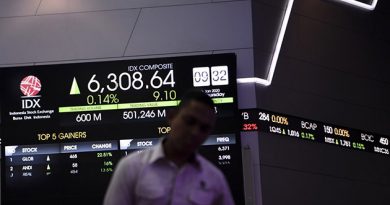Wall Street Calls Time Out on U.S. Dollar’s Big Resurgence

The U.S. dollar’s resurgence is running on fumes.
A short squeeze that sparked the greenback’s fastest rise in 18 months has fizzled out, according to Wall Street strategists, who warn of mounting bearish conditions for the currency: paltry domestic inflation, economic resilience overseas and the potential escalation of trade tensions.
For now, call last week’s sideways move in the Dollar Spot Index a “breather” after its torrid surge of more than 3 percent in three weeks. That was the biggest such gain since the weeks immediately following President Donald Trump’s November 2016 upset election victory.
Pause Button
U.S. inflation failed to accelerate in April, prompting the market to “hit the pause button” on the U.S. dollar rally, according to Mark McCormick, North American head of foreign exchange strategy at Toronto-Dominion Bank.
“The simple fact that it took three weeks to unwind a mix of positioning and valuation gaps that have been present since the start of the year underscores how sensitive the rally is to new (disappointing) information,” he wrote in a note Monday. “A mix of decent global growth and contained U.S. real rates reinforce our expectations that the recent surge was nothing more than a positioning squeeze.”
Any upside for the greenback from here should emerge at a much slower pace and peter out at around 94 on the Dollar Spot Index, the strategist reckoned, saying he expects a break below 90 in the second half of 2018.
Add bearish growls from ING Groep NV and Morgan Stanley to this chorus.
The Dutch lender agrees that a short squeeze with a limited lifespan is the proximate cause of the greenback’s lucky streak and suggests the euro has bottomed out against the currency.
Incoming U.S. data are unlikely to engineer a hawkish repricing of monetary expectations that would juice the U.S. dollar, strategists led by Chris Turner said in a May 11 note: “Unlike the more drawn out ‘taper tantrum’ of 2013 — there are signs that this vicious circle” — of higher U.S. rates and dollar gains — “may well be coming to an end.”
The greenback may benefit from relatively strong U.S. data and tighter Chinese monetary conditions for a while longer, according to strategists at Morgan Stanley. But that’s merely a cyclical rebound in the secular bear market that started in January 2017, as deficits fuel a funding gap that depreciates the currency.
“The U.S. dollar is likely to come under selling pressure again, due to the U.S.’s widening twin deficits,” Hans Redeker, Morgan Stanley’s global head of foreign exchange strategy, and his team wrote in a recent note. “The temporary strength in the USD into the summer should be faded as the longer-term bear trend re-emerges, with the DXY forecasted to reach 81 by end-2019.”
Yen Strength Eyed
Alvin Tan, director of currency strategy at Societe Generale SA, observes that the bond market is not confirming the narrative that the U.S. dollar’s rejuvenation is attributable to a pickup in the outlook for growth and inflation.
“A flattening yield curve is neither bullish nor bearish the dollar intrinsically, but it most definitely contradicts expectations of a U.S. reflation surge,” he wrote in a note to clients on Monday.
The strategist recommends selling the dollar against the yen should the pair hit 110, targeting a move to 104.
Bilal Hafeez, global head of G10 foreign-exchange strategy at Nomura, is also relishing the opportunity afforded by the recent advance in the world’s reserve currency to bet on its weakness relative to the yen. The market is mispricing the risks of an escalating trade war, in his view, which informs this “high” conviction call.
Technically Stretched
Even stalwart greenback bulls have trouble being enthusiastic about its near-term prospects.
“We are not convinced the third-largest dollar rally since the end of Bretton Woods is over despite the 2017 losses,” said Marc Chandler, head of currency strategy at Brown Brothers Harriman & Co., who anticipates that policy divergence between the Federal Reserve and other major global central banks will once again take hold as a positive driver for the U.S. currency.
But this rebound has left “technical indicators stretched,” he wrote Monday, and now the “breather” for the greenback has begun. He expects the Dollar Spot Index to sink back toward 91.3 to 91.8 in the coming days, with the euro reclaiming the psychological level of 1.20.
Courtesy : Bloomberg
photo : Furkan Haber
[social_warfare buttons=”Facebook,Pinterest,LinkedIn,Twitter,Total”]



